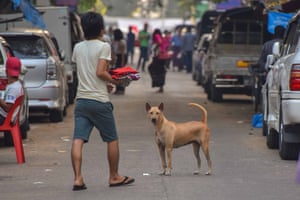Zu May Naing was playing with her brother outside their house in Bago Region, close to Myanmar’s commercial capital of Yangon, last month when a pack of stray dogs rounded on the 18-month-old.
Her mother, San Thar Myint, found her lying prone on the ground, bleeding and in shock. “Her temperature was over 100 [degrees fahrenheit] before they got to the operation room,” she says.
At the nearest children’s hospital in Yangon, doctors performed surgery and injected the baby with the anti-rabies vaccine. It was the second time that week a child had come in with dog bites. A doctor who declines to be named (he is not authorised to speak to the press) says they see between two and five cases per week.
A few days later, Zu May Naing’s arm is swaddled in bandages at the wrist where the dog seized her in its jaws. A red-brown gash sweeps from her left eye across her cheek. Another droops from the corner of her bottom lip where it was torn off. She glances fitfully around the hospital ward.
“She can’t sleep well at night,” her mother says. “She wakes up suddenly. She’s still afraid.”
Like many parts of the developing world, Myanmar has lived with stray dogs for generations. More than six decades ago, travel writer Norman Lewis described the mutts of Mergui, a coastal city in the south, with unsparing vividness: “There are more dogs than humans; they are a slinking, evil breed, cursed with every conceivable affliction … Many were earless, partially blind and had paralysed or dislocated limbs.”
For now, there is no killing – just breeding
The situation has not improved – and is arguably most acute in Yangon, the country’s rapidly developing commercial capital with a population of some five million. It is overrun with strays; government estimates seen by the Guardian put the number at more than 120,000. Some are scrawny creatures, rib cages pressing against flea-bitten skin, tumours flapping as they nose through rubbish carts. Others are visibly well fed, their muscular tawny torsos straddling spindly legs.
After dark, when the traffic clears and the air cools, some neighbourhoods descend into a chorus of howling. Others face more niggling problems: in a recent post on the local Facebook group “Eliminate All Stray Dogs”, one resident claimed an unruly pack kept jumping on his car, destroying its windscreen wipers.
“They occupy the streets – especially at night,” Ye Naung Thein, a local administrator, says at his office in Mingalar Taung Nyunt township.

For decades the government has sought to curb the ever-spiralling canine population with regular mass culls. But increased resistance from animal lovers has led authorities to take a different tack – much to the ire of people such as Ye Naung Thein.
Last July, he says, the Yangon City Development Committee (YCDC) – the city’s chief administrative body – banned the killing of all dogs in two areas: Sanchaung, and his neighbourhood, Mingalar Taung Nyunt.
It was a condition of an agreement signed last year with the global nonprofit Humane Society International (HSI) and the Bangkok-based Soi Dog Foundation, which are set to help Yangon authorities implement a project that would replace culling with a spay-and-neuter programme while also vaccinating dogs against rabies. Six months on, however, Ye Naung Thein has heard nothing about the plan; HSI says it is finalising a proposal.
“For now, there is no killing – just breeding,” he complains.
In the past month, two children have been bitten in his quarter alone – including four-year-old Thurein Lin. He and his mother, Zin Mar Min, were sitting at a teashop when one of the dogs milling around lunged for the boy, sinking its teeth into his skin. The same dog had bitten a different child earlier that day; the girl was in hospital for a week. The dog was later beaten to death.
“The residents are scared,” says Ye Naung Thein. “They are scared of sending their children on to the streets.”
The threat of rabies
As well as attacks, the dogs bring with them a graver threat: rabies. Invariably fatal once symptoms appear, the virus is now largely forgotten in the UK, though it was a real fear in the 19th century.
Today, it is Asia and Africa that bear the largest burden. The virus claims an estimated 50,000 lives a year, and Myanmar has the second-highest incidence of any country in south-east Asia with about 1,000 deaths per year, according to the World Health Organisation.
Last year, 41 patients with rabies were sent to Yangon General Hospital, the biggest in the city, according to its deputy medical superintendent Daw Khin Than Mon. But the overall number of victims is likely higher: “It’s hard to know the number of people bitten because people can go to the clinic or regional hospital,” she says.
In Yangon, once rabies patients are confined to the isolation ward in the hospital – a vast, colonial-era building with no air-con and sporadic fans – there’s not much else to be done. Most people die within a few days.
“It’s very depressing,” says one of the nurses, who asked not be named.

Yangon’s regular mass dog culls have involved municipal workers laying out poisoned meat; scooping up the corpses later. But this method is deeply divisive in the Buddhist-majority nation, where religious conviction strengthens a deep love for animals.
“I have a YCDC official friend who worked for the animal department,” says Ye Naung Thein. “I met with him a couple of months ago and he said he is happy now because he moved to another department and doesn’t need to do killing any more.
“I told him: ‘You are government staff and you’re doing the government’s work. Who said this is a sin?’ But he replied: ‘Buddha said he doesn’t like killing and this is the sin’.”
While allowing authorities to remove obviously rabid or sick animals, the culls did little to bring the population down or eliminate the virus. Animal experts and humane organisations say culling alone has never helped a city control its dog population.
“I mean, it’s just common sense,” says Rahul Sehgal, Asia director at HSI. “If you compare the statistics of rabies in a country that is undertaking culling over the years, you will hardly see any hint of reduction in the number of rabies cases.”
Indeed, studies show culls can actually worsen the problem by killing vaccinated animals, unsettling the population – leading to fights over territory – and keeping it young and more aggressive.
“What is happening is a kneejerk reaction,” says Sehgal. “It’s a symptom but we are not finding a cure.”
He advocates the “spay-neuter-release” strategy, which involves capturing animals, neutering and vaccinating them and letting them go in the exact place they were caught.
The method – which studies say have produced results in some cities, including Jaipur – is now enshrined in law in India and elsewhere. But it takes time to work.
“The dog population has existed for several decades,” says Sehgal. “You can’t bring it down in a couple of years – it’s not magic.”

‘We just want killing’
In her spacious office in the downtown YCDC building, Dr Hla May Oo, assistant head of the veterinary and slaughterhouse department, pulls a black plastic blowpipe out of a cardboard box and puffs into the tube.
“Stray dogs are very difficult to catch so we use a traditional method,” she says, laughing.
The city authorities carried out their own spay-and-neuter plan in one township late last year, sending municipal workers out with blowpipes loaded with anaesthetic.
Hla May Oo claims workers vaccinated and sterilised more than 70% of strays – the minimum threshold animal experts say must be met for population control to be sustained. Plans are under way to extend the campaign, funded by donations, to another township this month.
In the meantime, the department has stopped culling except on special request, aside from the two townships involved in the HSI project where it is banned outright.
Hla May Oo, who has led the department since 1988, says she is caught in the middle of what some are calling a war between dog lovers and dog haters. “We are receiving a lot of complaint letters every day,” she admits.
Ye Naung Thein is skeptical about the plan, having seen similar projects fall by the wayside in recent years.
“In our situation, a lot of corruption is happening everywhere,” he says. “We don’t how the money comes and what it goes on … We objected to the [spay-and-neuter] plan because we knew they would not do any follow-up after the project. We just want killing.”
Even in places where anti-rabies spay-and-neuter plans have showed signs of success, including Bali and some Indian cities, the expense of the programmes and the sheer terror of rabies has led governments back to culling.
“I live in India, which has 35 million stray dogs,” says Sehgal of HSI. “A massive amount of money is needed to do this, and [implementation of spay-and-neuter] has been sporadic there … You work for a year, you stop for a year. By the time you are coming back to it, the dog population has multiplied again.”
But if the efforts are sustained, Sehgal says, “it just cannot fail.”
The thing about culling, by contrast, is that the results can be seen straight away. As San Thar Myint cradles her baby in the hospital ward, she is in no doubt about what she wants.
“I want to kill these dogs – I don’t want to look at them,” she says. “I want to say that villages and residential areas should not have dogs.”
Additional reporting by Cape Win Diamond and Aung Naing Soe
Follow Guardian Cities on Twitter and Facebook to join the discussion, and explore our archive here
"I want to kill these dogs": question of whether to cull strays divides Yangon
Hiç yorum yok:
Yorum Gönder